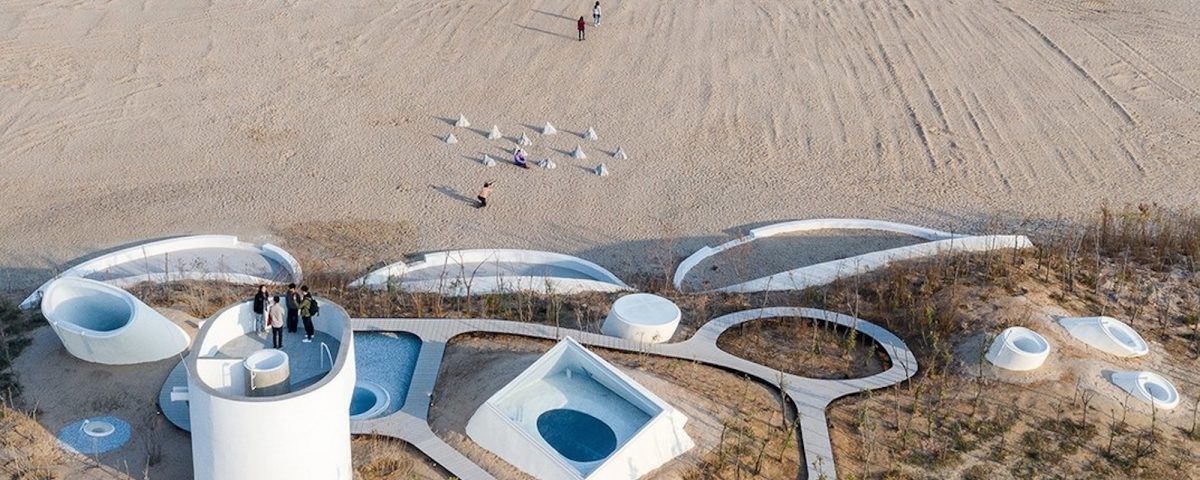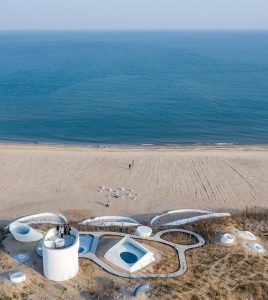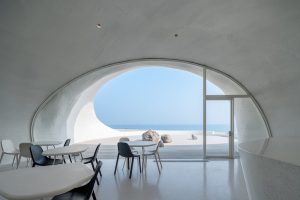UCCA Dune Art Museum in China by OPEN Architecture

Albert Cuyp underwater parking garage Amsterdam by ZJA Zwarts & Jansma Architects
June 14, 2019
The new MÉCA, Maison de l’Économie Créative et de la Culture en Aquitaine by BIG
July 9, 2019UCCA Dune Art Museum in China by OPEN Architecture
On a quiet beach along the coast of northern China’s Bohai Bay, the UCCA Dune Art Museum is carved into the sand, where it gently disappears. Countless years of wind have pushed the beach’s sand into a dune along the shore several meters high, stabilized by low-rising shrubs and other ground cover. The museum lies beneath this dune. Enveloped by sand, its interconnected, organically shaped spaces resemble caves—the primeval home of man, whose walls were once a canvas for some of humanity’s earliest works of art. Hidden between the sea and the sand, the design of the Dune Art Museum is simple, pure, and touching—a return to primal and timeless forms of space.
The decision to create the art museum underneath the dunes surrounding it was born out of both the architects’ deep reverence for nature and their desire to protect the vulnerable dune ecosystem, formed by natural forces over thousands of years. Because of the museum, these sand dunes will be preserved instead of leveled to make space for ocean-view real estate developments, as has happened to many other dunes along the shore.
A series of cell-like contiguous spaces accommodate differently-sized galleries, a café, and some ancillary spaces. After passing through a long, dark tunnel and a small reception area, the space suddenly opens up as visitors enter the largest multifunctional gallery. There, a beam of daylight from the skylight above silently yet powerfully fills the space.
Looking through different openings framed by the building, museum-goers can observe the ever-changing expressions of the sky and sea throughout the day. A spiral staircase leads to a lookout on top of the sand dune, guiding curious audiences from the dark recesses below to the vast openness above. Underfoot, the museum emerges as a hidden shelter, intimate to the body and soul—a place to thoughtfully contemplate both nature and art.
The complex three-dimensional geometry of the Dune Art Museum’s concrete shell was shaped by hand by local workers in Qinhuangdao (some of whom were former shipbuilders), using formwork made from small strips of wood and occasionally, some more elastic materials when tighter curvatures were needed. The architect deliberately retained the irregular and imperfect texture left by the formwork, allowing traces of the building’s manual construction to be felt and seen. In addition, the building’s doors and windows, reception desk, bar counter, and bathroom sinks are all custom-designed and made on-site. The eight tables in the café are also designed by the architect, each with a distinct shape matching that of the floor plans of the eight main gallery spaces.
The building’s many skylights, each with a different orientation and size, provide carefully tempered natural lighting for the museum’s spaces at all times of the year; its sand-covered roof greatly reduces the building’s summer heat load; and a low-energy, zero-emission ground source heat pump system replaces traditional air conditioning.
OPEN’s UCCA Dune Art Museum in Qinhuangdao, China, was awarded the “Best in Buildings Under 1,000 Square Metres” Winner of the 2019 AZ Awards, at the Awards Gala held in Toronto on June 21.
- UCCA Dune Art Museum aerial view
- Cafe
- Spiral Staircase
- Cafe night view
- Gallery skylight
- Rooftop
PROJECT FACTS
Design Year: 2015 – 2018
Status: Completed
Client: Aranya
Operator: UCCA
Program: Reception, Café, Community Room, Exhibition Spaces, Outdoor Exhibition, Roof Terrace
Building Area: 930 m²
Location: Qinhuangdao, China
CREDITS
Architects: OPEN Architecture
Principals in Charge: LI Hu, HUANG Wenjing
Project Team: ZHOU Tingting (Project Architect), WANG Mengmeng, HU Boji, FANG Kuanyin, Joshua PARKER, LU Di, LIN Bihong, YE Qing, Steven SHI, JIA Han
Local Design Institute: CABR Technology Co., Ltd.
Lighting Design: X Studio, School of Architecture, Tsinghua University, China + OPEN Architecture
Photographs: WU Qingshan, TIAN Fangfang, NI Nan, Zaiye Studio
About OPEN
OPEN is a passionate team of designers collaborating across different disciplines to practice urban design, landscape design, architectural design, and interior design, as well as the research and production of design strategies in the context of new challenges. We believe in the innovative power of architecture to transform people and the way they live, while striking a new balance between the manmade and nature. OPEN was founded by LI Hu and HUANG Wenjing in New York City. It established its Beijing office in 2008. Some built and ongoing projects by OPEN include: the Gehua Youth and Cultural Center, Garden School/Beijing No.4 High School Fangshan Campus, Tsinghua Ocean Center, Pingshan Performing Arts Center, Tank Shanghai, UCCA Dune Art Museum, Chapel of Sound, and Qingpu Pinghe International School. OPEN has been widely recognized for its innovative work. Recent awards the firm received include the 2019 P/A Awards (USA), 2018 AIA Education Facility Design Award of Excellence (USA), 2018 Civic Trust Awards (UK), 2017 Iconic Awards Best of Best (Germany), 2016 Interior Design’s Best of Year (USA), 2015 AIANY Design Award (USA), 2015 London Design Museum’s Design of the Year Nomination (UK), and the Winning Prize of the WA Awards for Chinese Architecture, among many others. OPEN has been invited to participate in many important international exhibitions, such as China House Vision in Beijing in 2018, “Soul of the City” in Verona, Italy in 2017, the inaugural Chicago Architecture Biennial in 2015, and the Chinese pavilion at the Venice Biennale in 2014.










